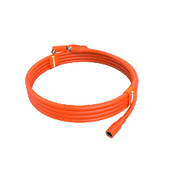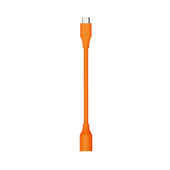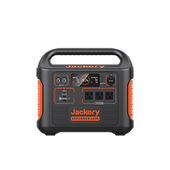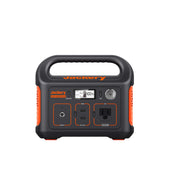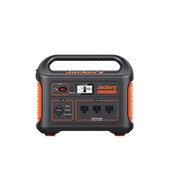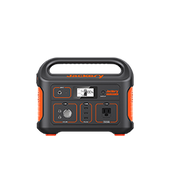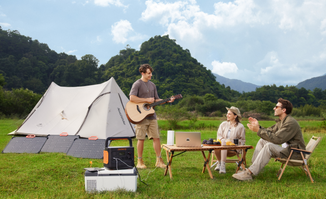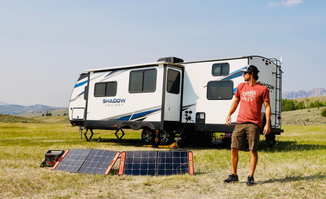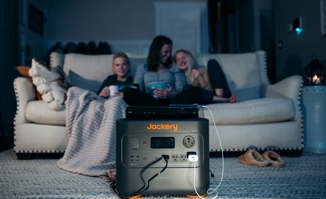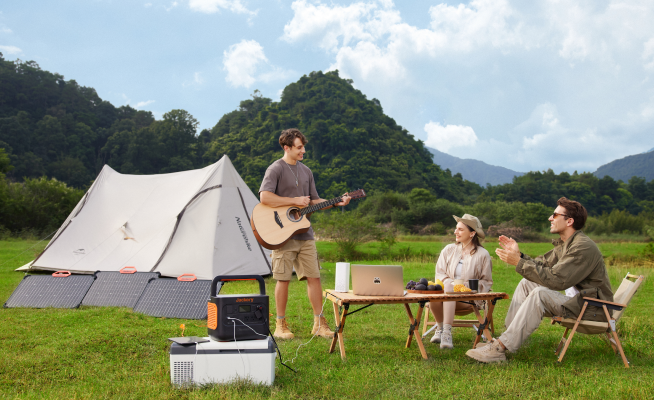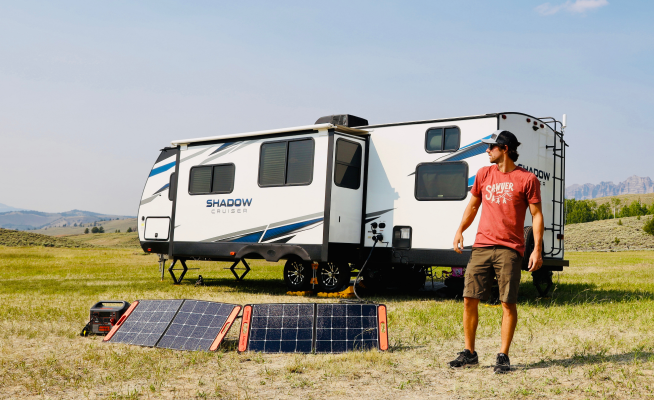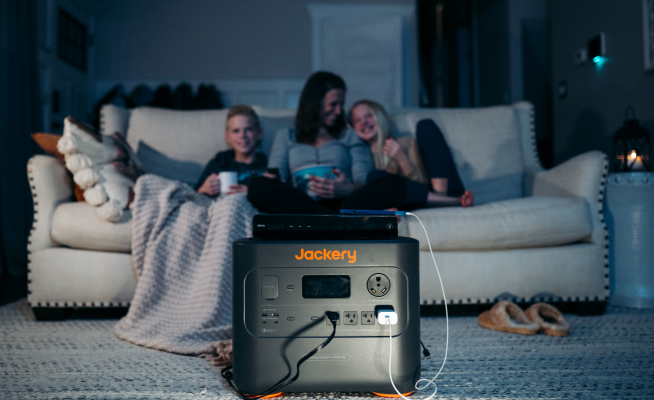Solar Powered TV: Can Solar Generator Run a TV
It's simple to lose hours in front of the TV while trying to unwind, but if you're viewing at home, all that time can add up to a sizable electricity bill.
A TV uses 58.6 Wh when it is on and 0.5 Wh when in standby state on average per hour, and its average amp draw is 0.49 Ah. As a result, the monthly electric cost can reach $2.52.

Powering a TV using solar power can help reduce not only your carbon footprint but your electricity bill as well. Jackery solar generators come in different capacities and dimensions, suitable for all types of TVs. On this page, you will learn what solar-powered TV is, how it works, and can a solar generator run a TV.
What is Solar Powered TV
You can enjoy virtually endless off-grid, remote amusement with a solar-powered TV. The solar-powered TV is an easy-to-use, ready-to-use option. The TV is in the viewing area, and an appropriate outdoor location is chosen for the solar panel and intelligent antenna. The internal battery can be changed if required.
This makes the TV one of the significant energy users in your home. The more time we spend watching TV, our utility costs increase, especially in these difficult times. Many people are switching to solar-powered TVs to reduce expenses.
How Does A Solar Powered TV Work
While a solar panel generates DC, a television utilizes AC. You can harness the DC power generated by the solar cells to power the TV using solar energy.
Once you've gathered it, you can store this DC in a battery or an inverter, automatically converting the power from DC to AC, enabling you to run all your domestic appliances. One method of powering your TV or other solar-powered equipment is to convert DC to AC.

Solar Powered TV VS. Solar Generator for TV
The typical American consumes 3–4 hours of TV daily; if you binge-watch on streaming, that number is likely much higher. Since its creation, the TV has enriched our lives and is now regarded as a necessity.
A 150W solar screen can power a 50-inch TV for 4–5 hours per day when used as a solar-powered TV. You can extend the time you can watch TV on solar power by several hours by adding a 50Ah battery and inverter to the setup.
However, solar cells might not function on cloudy or nighttime days.Solar generators provide another way to power a TV, keeping you powered even at night, during rainy weather, or on cloudy days with their fully charged portable power stations. Additionally, it allows charging via your outlet, garage, and solar panels.
|
Types |
Pros |
Cons |
|
Solar Powered TV |
- Clean energy - Save electricity bills - Using during blackouts - Suitable for off-grid-living |
- Not work better on rainy or cloudy days - Need installation - Need battery - Need inverter - Need maintenance - Require TV to be compatible with solar power |
|
Solar Generator for TV |
- Allows you to charge TV any time anywhere, - Portable, easy to carry - Power even at night, on rainy or cloudy days from its fully charged portable power station - Pass through charging - Multiple recharging methods - Combine solar panels with power stations - No maintenance costs |
- Some solar generators with large capacities may cost a lot |
Solar Powered TV
A TV can now be powered by solar energy without an off-grid power source. You'll need solar panels and a few other tools to power your TV with solar energy. However, you must first make sure that your TV is compatible with solar electricity before you start using it for your TV.
Due to the quick advancement of technology, it is now possible to find TVs that directly utilize the sun's power through integrated solar panels. These TVs are specifically made to assist customers in reducing their utility costs. In general, solar-powered TVs typically have a DC fan that is powered solely by the sun.
Solar Generator for TV
Portable solar generators can power a variety of appliances both inside and outside the house. It converts solar power into electricity and stores the energy for later use. Thanks to this, you can still enjoy off-grid living, camping, outdoor activities, or even when you are not linked to the electrical grid.

The solar generator is the best option for charging TVs and other appliances, unlike solar-powered TVs requiring installation, the right equipment (battery, inverter), and maintenance.
It is a clean energy source, economical, and appropriate for backup power, off-grid living, camping, and more.
For example, Jackery Solar Generator 1000 Plus is best for charging a 60W TV for about 13 hours, which means you could be the couch potato for half of the day.
How Many Watts Does A TV Use
The average TV uses 150 watts. Depending on the brand, size, and other variables, the wattage of your device may vary. The user manual or the actual gadget will usually have the wattage of your TV listed.
The amount of power a TV typically consumes varies greatly depending on the type you have and ranges from 50 to 200 watts. A specific assumption for the typical electricity consumption of contemporary TVs from reputable manufacturers is 100 watts. 54.75 kilowatt-hours of energy are consumed annually by watching TV for 21 hours per week.
The most significant factor affecting how much electricity your TV consumes over time is how often you use it, and households have different television-watching schedules. It's interesting to note that over the past few years, the average time American adults spend viewing TV has decreased, now hovering around 3 hours per day.
How Much Cost to Run A TV
You don't get to see how much each appliance costs when you receive your monthly electric bill; you can only see the total sum you're charged. Based on a TV's typical power of 100W.
|
State |
Average Electricity Rate |
Cost Per Month |
Cost Per Year |
|
California |
22.0 ₵/kWh |
$2.0 |
$24.1 |
|
New York |
20.6 ₵/kWh |
$1.9 |
$22.6 |
|
Texas |
12.6 ₵/kWh |
$1.2 |
$13.8 |
|
Florida |
12.2 ₵/kWh |
$1.1 |
$13.4 |
|
New Jersey |
16.2 ₵/kWh |
$1.5 |
$17.7 |
|
Washington |
10.4 ₵/kWh |
$1.0 |
$11.4 |
|
US Average |
14.2 ₵/kWh |
$1.3 |
$15.6 |
How Much Solar Power Need to Run A TV
TVs come in a variety of styles, dimensions, and features. The table below displays the required solar electricity and the wattage for typical TV sizes.
Because they are no longer in use, plasma and CRT Televisions are omitted. If you still own a plasma TV, consider upgrading to an LED or LCD instead because plasma consumes twice as much electricity as LED and LCD.
|
LCD TV |
Watts Per Hour |
LED TV |
Watts Per Hour |
Solar Power Needed |
|
32 Inch |
24W-72W |
32 Inch |
20W-60W |
80W-90W |
|
42 Inch |
72W |
42 Inch |
60W |
80W-90W |
|
46 Inch |
72W-84W |
46 Inch |
60W-70W |
100W |
|
50 Inch |
102W |
50 Inch |
85W |
150W |
|
65 Inch |
146W-156W |
65 Inch |
120W-130W |
200W |
|
82 Inch |
276W-360W |
82 Inch |
230W-300W |
400-500W |
Can A Solar Generator Run A TV
Absolutely yes! A solar generator is the best option for an off-grid, RV, or compact or medium-sized home TV. Jackery portable solar generators use clean solar energy to power your devices. For instance, you can power a large-screen TV during a power outage or carry the generator during camping to charge your mini TV.
The solar generator combines the SolarSaga solar panels with a portable power station, which absorbs solar energy from solar panels and turns it into electricity via the power station. Solar generators for TV are more portable and affordable than solar-powered TV.

Depending on your power needs and the number of appliances, Jackery offers a variety of solar power generators. For example, you can select a Jackery solar generator 2000 pro or 1500 pro to charge your large-size TV, whereas the solar generator 1000 pro or 500 can power small-inch TV during off-the-grid or camping.
|
Series |
Capacity |
Ports |
TV Watts |
Hours |
|
2160Wh |
AC Output: 120V, 60Hz, 2200W (4400W Peak) USB-A Output: Quick Charge 3.0, 18W Max USB-C Output: 100W Max, (5V, 9V, 12V, 15V, 20V up to 5A) Car Output: 12V, 10A |
32 Inch: 20W-60W 42 Inch: 60W 46 Inch: 60W-70W 50 Inch: 85W 65 Inch: 120W-130W 82 Inch: 230W-300W |
32 Inch: 91.8H to 30.6H 42 Inch: 30.6H 46 Inch: 30.6H to 26.2H 50 Inch: 21.6H 65 Inch: 15.3H to 14.1H 82 Inch: 8H to 6.1H |
|
|
1534Wh |
AC Output: 110V, 60Hz, 1800W (3600W Peak) USB-A Output: 5V, 2.4A Quick Charge 3.0, 18W Max, 5-6.5V, 3A/6.5-9V, 3A / 9-12V USB-C Output: PD60W, (5V, 9V, 12V, 15V, 20V up to 3A) Car Output: 12V, 10A |
32 Inch: 20W-60W 42 Inch: 60W 46 Inch: 60W-70W 50 Inch: 85W 65 Inch: 120W-130W 82 Inch: 230W-300W |
32 Inch: 65.2H to 21.7H 42 Inch: 21.7H 46 Inch: 21.7H to 18.6H 50 Inch: 15.3H 65 Inch: 10.9H to 10H 82 Inch: 5.7H to 4.3H |
|
|
1002Wh |
AC Output: 120V, 60Hz, 1000W (2000W Peak) USB-A Output: Quick Charge 3.0, 18W Max USB-C Output: 12V, 10A Car Port: 120V, 60Hz, 15A Max |
32 Inch: 20W-60W 42 Inch: 60W 46 Inch: 60W-70W 50 Inch: 85W 65 Inch: 120W-130W 82 Inch: 230W-300W |
32 Inch: 42.6H to 14.2H 42 Inch: 14.2H 46 Inch: 14.2H to 12.2H 50 Inch: 10H 65 Inch: 7.1H to 6.6H 82 Inch: 3.7H to 2.8H |
Solar Powered TV FAQs
The following shows the frequently asked questions about the solar-powered TV:
1. What Size Solar Generator Do I Need to Run A TV?
Watts and watt-hours are the units used to describe a generator's output. Wattage is a measurement of the force required to transfer energy. The more electricity a solar generator can produce for you on a single charge depends on its capacity. According to the different sizes of TV, you can choose other solar generators from Jackery.
Here is a mathematical formula to determine how long it will take to power your TV using Jackery solar generators:
Working time = solar generator capacity*0.85 / operating wattage of your TV
For example, if you use Jackery solar generator 1000 pro (1002Wh capacity) to charge your TV, and your TV needs to consume 100 watts, the working time equals 8.5 hours (1002W*0.85 / 100W).
2. Can A 100W Solar Panel Run A TV?
Yes. A 100W solar panel can power an average modern TV with 58.6W of energy. The panel will more easily powerless powerful TVs. To guarantee that enough power is constantly supplied to the TV, battery storage should be used in addition to the 100W panel.
3. How to install a solar-powered TV?
The following materials are required to set up a solar-powered television:
- A device that transforms photovoltaic panels' DC into AC.
- A battery to supply power to the 12V converter.
- To avoid overcharging, overcurrent, or current overflow, a charge controller can modify the charge according to the battery's needs.
- Remember that the energy is based on the size of your battery and whether you want to use the panel for power conditioning or the entire TV load.
Final Thoughts
It's simple to make a TV operate on solar power. You will need batteries, installation, maintenance, and the proper inverter to set up your solar-powered TV. A portable solar generator might be the best option for powering a TV and other devices. Jackery solar generators with different capacities and sizes suit your needs!
Disclaimer:
The runtime mentioned for appliances powered by Jackery is for reference only. Actual runtime may vary under different conditions. Please refer to real-world performance for accurate results.






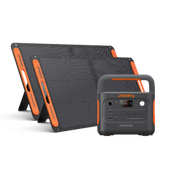


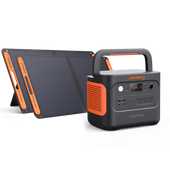

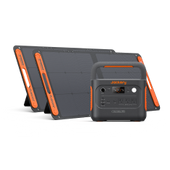
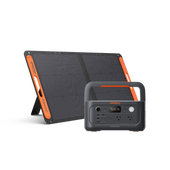
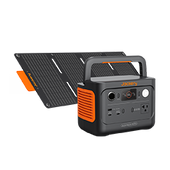
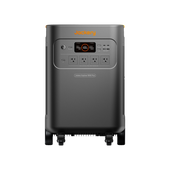
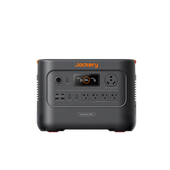
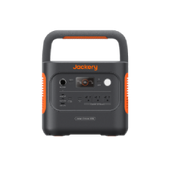
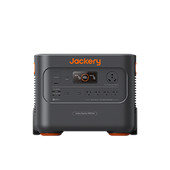
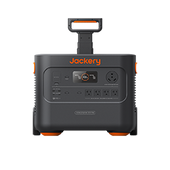

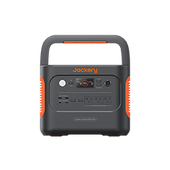
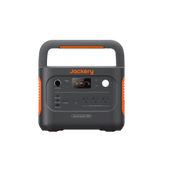
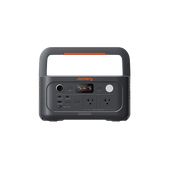

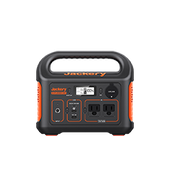
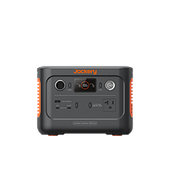
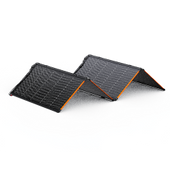
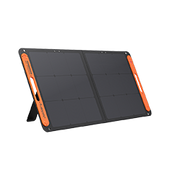

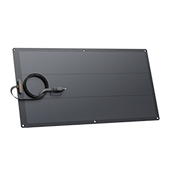
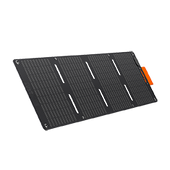
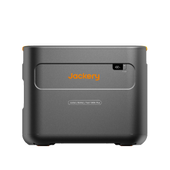
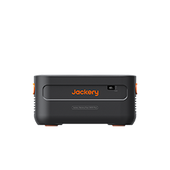
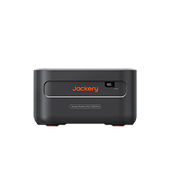
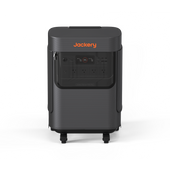
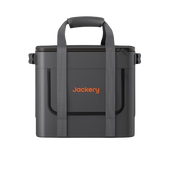


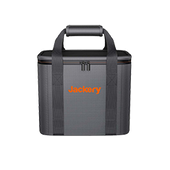
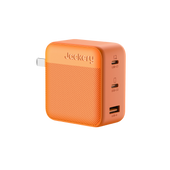
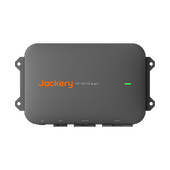
![[Add-on] Jackery Manual Transfer Switch for Explorer 5000 Plus](http://ca.jackery.com/cdn/shop/files/add-on-jackery-manual-transfer-switch-for-5000-plus-240V.webp?v=1757043692&width=170)
